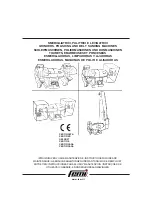
! Warning !
Read and follow all instructions. Not doing so may lead to an electric shock
injury, fire or other serious injuries. Improper use of the tool may result in the
warranty loss. The term 'electric tools' in all further context refers both to
electric tools powered by standard electrical network (sockets) and tools
powered by batteries.
Be aware of the following instructions and keep them safe!
1) Work area
a)
Keep work area clean and well lit. Cluttered areas invite injuries.
b)
Avoid manipulation with electric tools at areas with dangerous objects,
such as flammable liquids, gases or dust. Tools are sources of sparks
which can set dust or fumes on fire.
c)
Do not let visitors and children manipulate tools. All visitors should be
kept away from work area.
2) Electric safety
a)
The power cord plug shall always suit the socket. Never adjust the
socket. Do not use plug hubs. Non-adjusted plugs and appropriate
sockets reduce the risk of electric shock injury.
b)
Prevent body contact with conductive surfaces to avoid a risk of electric
shock injury.
c)
Do not expose the tool to rain or wet locations. Presence of water in
electric tool highly increases the risk of electric shock injury.
d)
Do not force the cord. Keep the cord away from heat sources, oil, sharp
edges or movable parts. Damaged cord increases a risk of electric
shock injury.
e)
When manipulating in exterior areas consider an extension cord
intended for outdoor use specifically. Using an exterior extension cord
decreases a risk of electric shock injury.
f)
It is strictly recommended to use a ground fault circuit interrupter (GFCI)
when manipulating the tool in a wet area. Using of GFCI decreases a
risk of electric shock injury.
g)
A double insulated tool is equipped with a polarized plug (one prong is
wider than the other). If the connector does not fully suit the socket, turn
the plug. Do not change the plug by any means. Double insulation
eliminates the need for grounding of power cord and power supply
system.
3) Personal safety
a)
Stay alert and do not use the tool when under influence of alcohol.
b)
Use safety glasses and face or dust mask. Wear protective hearing
equipment, helmet and boots.



































